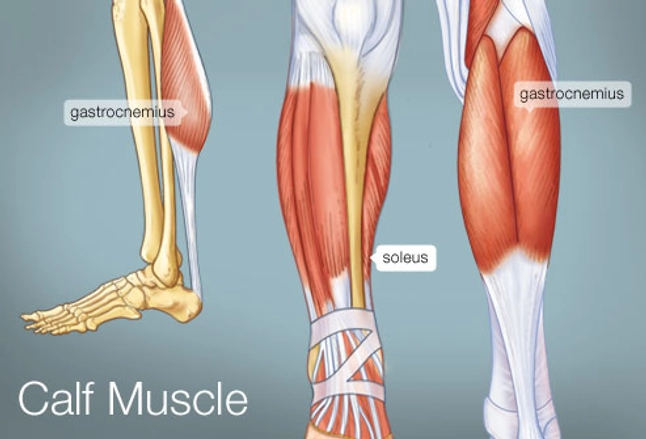
The calf muscle, on the back of the lower leg, is actually made up of two muscles:
- The gastrocnemius is the larger calf muscle, forming the bulge visible beneath the skin. The gastrocnemius has two parts or "heads," which together create its diamond shape.
- The soleus is a smaller, flat muscle that lies underneath the gastrocnemius muscle.
The gastrocnemius and soleus muscles taper and merge at the base of the calf muscle. Tough connective tissue at the bottom of the calf muscle merges with the Achilles tendon. The Achilles tendon inserts into the heel bone (calcaneus).
During walking, running, or jumping, the calf muscle pulls the heel up to allow forward movement.
Calf Muscle Conditions
- Calf muscle strain: Stretching the calf muscle past its normal length results in tearing of some calf muscle fibers. Calf muscle strains can vary from mild (slight pain) to severe (complete tear of the calf muscle).
- Pulled calf muscle: A calf muscle strain is commonly called a pulled calf muscle. "Pulling" the muscle refers to stretching the calf muscle beyond its limit.
- Calf muscle tear: All calf muscle strains result in tearing of some muscle fibers. More serious injuries may result in partial or complete tear of the calf muscle.
- Calf muscle rupture: Complete tear of the calf muscle, resulting in severe pain and inability to walk. The calf muscle may collapse into a lump or ball shape, seen and felt through the skin.
- Calf muscle myositis: Inflammation of the calf muscle. Infections or autoimmune conditions (caused when the immune system mistakenly attacks the body's own tissues) are usually responsible, although calf muscle myositis is rare.
- Rhabdomyolysis: Calf muscle breakdown due to long-term pressure, drug side effects, or a severe medical condition. Rhabdomyolysis usually affects multiple muscles throughout the body.
- Calf muscle cancer: Cancer of the calf muscle is uncommon. The tumor may start in the calf muscle (called sarcoma) or spread to the calf muscle from elsewhere (called metastasis).
Calf Muscle Tests
- Magnetic resonance imaging (MRI scan): An MRI scanner uses a high-powered magnet and a computer to create highly detailed images of the calf muscle and other leg structures.
- Computed tomography (CT scan): A CT scanner takes multiple X-rays, and a computer compiles the X-rays into images of the calf muscle and other structures in the leg.
- Calf muscle ultrasound: A device placed on the skin bounces high-frequency sound waves off the calf muscle, tendon, and other structures in the leg. The signals are converted into images on a video screen, allowing health-care providers to see structures inside the body.
Continued
Calf Muscle Treatments
- PRICE therapy: Protecting, Resting, applying Ice, Compression (such as wrapping the area with an elastic bandage), and Elevation are good treatments for most calf muscle strains.
- Calf muscle surgery: Surgery may be required for a total tear of the calf muscle, or to remove a calf muscle sarcoma.
- Chemotherapy: Medicines that kill cancer cells may be given to help treat sarcoma or other cancer affecting the calf muscle.
- Radiation therapy: High-energy radiation directed at cancer cells may be part of the treatment for sarcoma or other cancer affecting the calf muscle.
- Corticosteroids: Prednisone and similar cortisone-like medicines suppress the immune system and can treat some forms of myositis affecting the calf muscle.
- Antibiotics: Medicines that kill bacteria can help treat some forms of myositis affecting the calf muscle.
- Physical therapy: For some cases of calf muscle weakness or injury, an exercise program designed and supervised by a physical therapist can help restore strength and function of the calf muscle.